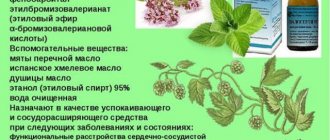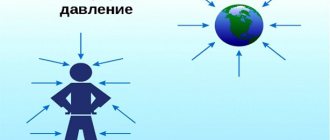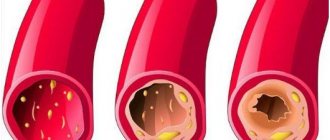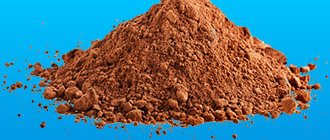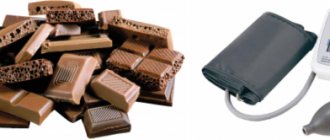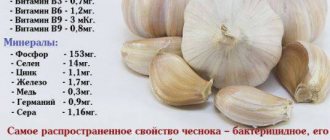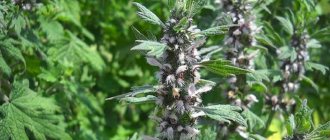Attacks of headaches or any other pain significantly worsen the quality of life.
Taking a pain reliever such as Nise tablets seems to be a good solution.
But hypertension teaches you to be very careful when choosing medications.
Hypertension is not an absolute contraindication for taking Nise. But, like any medicine, Nise has limitations. Its use is possible only after the doctor's approval.
Letters from our readers
Topic: Grandma's blood pressure has returned to normal!
From: Christina ( [email protected] )
To: Administration otgipertonii.ru
Christina, Moscow
My grandmother’s hypertension is hereditary - most likely, I will have the same problems as I get older.
I accidentally found an article on the Internet that literally saved my grandmother. She was tormented by headaches and had a repeated crisis. I bought the course and monitored the correct treatment.
After 6 weeks she even started talking differently. She said that her head no longer hurts, but she still takes pills for blood pressure. I am sending a link to the article
Indications for use
Nise is an anti-inflammatory pain reliever.
Applicable in the following cases:
- gout;
- osteochondrosis;
- arthritis;
- Bekhterev's symptom;
- fever;
- osteoarthritis;
- inflammation of tendons and ligaments;
- pain of various etiologies (migraines, menstruation, period after surgery, toothaches, etc.).
In addition, the drug has an antioxidant effect, prevents the destruction of cartilage and platelet aggregation.
We recommend reading: What points on the body to press for headaches
Does Nise increase or decrease blood pressure?
Let's consider how the drug Nise acts on the human cardiovascular system: does it increase or decrease blood pressure, does it help with a hypertensive or hypotensive attack?
Nise is a drug from the NSAID group that is taken for inflammation, aching joints, and fever. The drug eliminates all unpleasant symptoms within 10-15 minutes, stabilizing the patient’s condition. Available in the form of tablets for oral administration.
Composition and pharmacological properties
Active ingredient: nimesulide:
- normalizes body thermoregulation, reducing temperature;
- stops inflammatory processes;
- reduces pain.
In addition to nimesulide, Nise contains:
- calcium phosphate;
- sodium glycolate;
- corn starch;
- E341;
- MCC.
Taking the medicine is recommended for:
- increased body temperature;
- articular syndrome during exacerbation of gout;
- rheumatoid and psoriatic arthritis;
- ankylosing spondylitis;
- osteorathrosis;
- osteochondrosis with radicular syndrome;
- radiculitis;
- inflammation of ligaments, tendons;
- sciatica;
- muscle pain of rheumatic/non-rheumatic origin;
- post-traumatic inflammation of soft tissues and the musculoskeletal system;
- headaches;
- toothache.
The analgesic effect of taking the drug is observed after 10-15 minutes. The active substance reaches its maximum concentration in the blood after 40-50 minutes. Nise components are excreted from the body through the kidneys along with urine.
Effect on pressure
Nise increases blood pressure, so use is contraindicated for hypertensive patients. Even 1 tablet taken with high blood pressure can trigger the onset of a hypertensive crisis.
The substances included in the drug help retain fluid in the body. It compresses the walls of blood vessels, narrowing their lumen and preventing the normal movement of blood. As a result, blood pressure increases and the patient's general condition worsens.
Taking Nise is allowed only for hypotension. However, it is not taken for the purpose of increasing blood pressure, but to eliminate the unpleasant symptoms that accompany the disease (headaches, body aches, fever).
Since the medicine puts a strong strain on the urinary system, it is impossible to take the drug for more than 5 days. Extension of therapy is possible only with the permission of the doctor. After treatment, it is recommended to undergo blood and urine tests to make sure there are no complications.
Mode of application
The method of taking the drug is individual. If it is a toothache, headache or muscle pain, the medication is taken once, 1 tablet before meals.
In the case of inflammation, high fever, joint pathologies, Nise is taken 2 times a day, 1 tablet half an hour before meals.
If stomach pain or discomfort occurs during treatment, the drug should be taken during meals. Duration of therapy is 5 days.
Adverse reactions
As practice shows, Nise is well tolerated by patients. But there are cases of adverse reactions. They appear, as a rule, when dosages are not observed or during long-term treatment. The most common among them are:
- nausea, vomiting;
- bowel dysfunction;
- flatulence;
- erosive lesions of the upper digestive system;
- internal bleeding from ulcerative defects.
Despite the fact that compared to other anti-inflammatory drugs, Nise is much less likely to cause fatal bleeding, there is a risk of such complications, especially in people taking the pills for a long time.
In addition, the product has analgesic properties and eliminates erosive lesions. Therefore, if during treatment there is a change in the color of the stool (it becomes black or dirty gray), you should immediately seek help from a doctor.
Among other dangerous complications, rapidly developing toxic hepatitis should be highlighted. In this case, cases often arise when hepatitis is complicated by liver failure and ends in death. Such cases are rare, but they do exist. Therefore, Nise should be taken under strict medical supervision.
Effect on blood pressure
For patients suffering from hypertension, the question of whether Nise increases or decreases blood pressure is a very pressing question. Experts believe that in case of all kinds of surges in blood pressure, it is necessary to use the drug with great caution.
Don't tolerate high blood pressure
Now hypertension can be cured by restoring blood vessels...
>
It has been established that, once it enters the tissue, the active substance of the drug is capable of retaining fluid in the body, causing swelling, which, in turn, leads to a narrowing of the capillary walls, thereby increasing blood pressure. In addition, each person's body is individual and may react to therapy in unexpected ways.
To avoid worsening the condition, the patient must carefully monitor his blood pressure. Sometimes hypertensive patients are still prescribed Nise in small doses together with medications that lower blood pressure. In any case, you should not self-medicate; only a doctor can prescribe pharmaceuticals.
Nise and pressure
You can use Nise for high blood pressure only after consulting a doctor who can predict a possible reaction to the drug.
This pharmaceutical product has a strong anti-inflammatory and analgesic effect, which allows it to be used to eliminate the source of inflammation and relieve pain.
But, like all medications, “Nise” has a number of restrictions on its use, and although arterial hypertension is not an absolute contraindication, the medication should be used with blood pressure surges carefully and only after approval by a doctor.
Release form and composition
The drug is sold in the form of tablets and suspensions for oral administration. “Nise” is based on the active component nimesulide and the following additional substances (for tablets):
- MCC;
- corn starch;
- food additive E341;
- magnesium stearate;
- Aerosil;
- flavoring;
- sodium glycolate.
"Nise" belongs to the group of non-steroidal anti-inflammatory drugs, the action of which is aimed at relieving edema and suppressing the synthesis of mediators of the inflammatory process. The medicinal substances of the drug entering the body have a pronounced analgesic, decongestant and antipyretic effect.
In addition, “Nise” has the ability to thin thick blood, thereby preventing swelling, and inhibit the process of platelets sticking together.
After the first days of use, patients can experience relief: pain in the area of bone joints will go away, motor activity of the joints will improve and swelling at the site of the inflammatory focus will disappear.
How does it affect blood pressure?
The drug helps to narrow the vascular walls.
Doctors strongly recommend that patients with high blood pressure use Nise with extreme caution.
It is believed that nimesulide is capable of changing blood pressure, but the situations when it raises or lowers blood pressure directly depend on the personal characteristics of the person.
One way or another, penetrating into tissue structures, the components of the Nise drug retain fluid in the body, resulting in swelling and sharply narrowing the walls of blood vessels. Therefore, the drug increases blood pressure.
To prevent complications of high blood pressure when using Nise, you need to regularly monitor blood pressure readings during therapy.
Indications and contraindications
The therapeutic effect of the anti-inflammatory drug “Nise” extends to the following pathological conditions:
- lumbago;
- gout;
- osteoarthritis;
- rheumatoid arthritis;
- osteochondrosis;
- Bekhterev's disease;
- feeling of stiffness in the morning;
- painful sensations in joints and muscles;
- inflammation in ligaments, joint capsule, tendons;
- pain of various etiologies;
- fever.
The drug is useless for bronchial asthma.
In addition to the fact that “Nise” cannot always be used for problems with blood pressure, it will also need to be abandoned in case of individual intolerance to its constituent components, severely impaired activity of the kidneys and liver, as well as in case of erosions in the organs of the digestive system and bleeding from the gastrointestinal tract . "Nise" is contraindicated for children under 12 years of age, pregnant and nursing mothers. The medicine will not bring the expected therapeutic effect if used for atopic dermatitis or bronchial asthma.
How is it used for pressure?
If the doctor sees no reason to refuse the patient to take Nise, then the patient can safely use it, strictly observing the prescribed dosage. According to the instructions, you should take 1 tablet at a time. in the morning and evening half an hour before meals.
If discomfort occurs in the abdominal area, the medication should be taken during meals. Elderly people are better off using the liquid form of "Nise".
It is believed that the suspension is absorbed faster and has a lower risk of developing side symptoms.
Side effects
During therapy with the non-steroidal anti-inflammatory drug in question, the following undesirable effects may appear:
In some people, taking the drug causes sour belching.
- painful discomfort in the epigastric region;
- nausea;
- loss of appetite;
- gag reflex, nausea;
- belching sour;
- frequent loose stools;
- burning in the esophagus;
- flatulence;
- headaches, dizziness;
- rashes on the skin;
- bronchospasm;
- hives;
- anaphylactic shock.
If you observe a negative reaction of the body to taking Naiza, you should stop treatment and consult a doctor.
Storage conditions
Tablets and suspension should be stored in a place where moisture and sunlight do not reach, and the air temperature does not rise above 24 °C. The shelf life of the medicine is 3 years. Contraindicated for use after the specified period. It is important that young children do not have access to the anti-inflammatory drug.
Source: //VseDavlenie.ru/lekarstva/obezbolivauschie/nayz-ot-davleniya.html
Release form
The medication is produced in several forms:
- tablets (each containing 100 mg of substance);
- dispersible tablets (that is, resorbable), contain 50 mg of the substance;
- gel 1% - applied externally;
- suspension (contains 50 mg of active substance in 5 ml of solution).
The choice of form depends on the individual characteristics of the organism, age and complexity of the diagnosis.
Instructions for use
The procedure for taking the drug is determined by the doctor. In general, the following recommendations are given:
- Tablets are taken twice a day, 30 minutes after meals. For stomach pain, you can take the drug with food. The daily dose should not be more than 400 mg.
- Dispersible tablets are dissolved in water. For one tablet you need a dessert spoon of clean water without gas. Take 100 mg 2 times a day (adults) and 3 mg per 1 kg of weight for children.
- The suspension should be drunk after meals. Most often, this form of release is prescribed to children and elderly patients, since the suspension is easily absorbed.
- The gel helps well with bruises, injuries, stretch marks, and inflammation. It should be applied to the desired area and rubbed in, massaging for about 5 minutes.
Use in pediatrics and pregnancy
Nise is a drug that relieves pain and muscle inflammation. Pregnant women who experience back pain try to alleviate their condition. However, the period of bearing a child is a special condition of the body in which taking Nise in tablet form is strictly contraindicated.
Nimesulide, penetrating the body, can affect the development of the fetus:
- up to 2 weeks, taking Nise either leads to the death of the embryo or is tolerated without any consequences;
- drug treatment during the formation of internal organs causes severe disruption of this process.
Taking the drug Nise, regardless of the trimester of pregnancy, is dangerous for the fetus. Women believe that using the gel (externally applied to problem areas) is safe for the embryo. But that's not true. The active ingredient nimesulide, even when applied topically, penetrates the blood of the expectant mother and affects the development of the baby.
Nise in the form of a suspension is used to treat children over 2 years of age. The suspension is a good antipyretic, but it is prescribed in extreme cases due to the negative effect of the active substance on the liver. The dosage of syrup is calculated by the doctor taking into account the patient’s body weight.
Side effects
During treatment with Nise, some undesirable reactions may occur:
- diarrhea;
- lack of appetite;
- rash;
- nausea;
- burning in the stomach;
- belching;
- dizziness;
- dyspnea;
- anaphylactic shock.
Allergies are also possible (if there is intolerance to any of the components). The patient who feels a deterioration in his condition should stop therapy and inform the attending physician.
Side effects of Nise, features of the use of non-steroidal drugs
Pain is characteristic of many diseases.
They occur especially often when the osteoarticular system is damaged and due to domestic injuries. To alleviate the suffering of the patient and relieve local inflammation, Nise is often prescribed. It significantly helps patients get rid of the symptoms of the disease. However, the drug is not flawless; Nise causes serious side effects, including life-threatening ones
How does the medicine work?
Nise is the trade name of the medicine. The drug is based on one active principle – nimesulide. This is a classic second generation non-steroidal anti-inflammatory drug.
The mechanism of therapeutic action is based on the ability of the substance to suppress the activity of the pro-inflammatory enzyme - cyclooxygenase. As a result, prostaglandins, mediators of inflammatory changes, are not produced.
This leads to the disappearance of swelling and pain in the affected tissues. Nise also facilitates the movement of blood through the vessels, which improves blood supply to the affected area.
The main effects of the drug look like this.
- Analgesia
- Relieving inflammation
- Relieving swelling
- Improving microcirculation
- Improving the reparative capabilities of tissues
The medicine is used internally. After absorption, after 2 hours it creates a maximum concentration in the blood. The therapeutic effect lasts up to 6 hours. It is excreted via the kidneys and bile.
About how non-steroidal drugs work. what side effects of the drug Nise should patients be wary of - look at the video:
When is Nise used?
Since the medicine has an anti-inflammatory and analgesic effect, its use is possible for all diseases of the musculoskeletal system accompanied by similar symptoms.
The most common indications for prescribing the drug are listed below.
- Acute pain in any part of the spine
- Chronic systemic joint disorders, such as rheumatoid arthritis
- Pain due to gout
- Psoriatic arthropathy
- Bruises with pain syndrome
- Sprain
- Toothache
- Algomenorrhea
The drug is used internally. The average dose for persons over 12 years of age is 200 mg per day. The frequency of administration is 2 times.
When the drug should not be used
Nise has numerous contraindications.
The most important ones are listed below:
- Pregnancy
- Lactation
- Aspirin intolerance
- Bronchial asthma
- History of gastric bleeding
- Exacerbation of peptic ulcer
- Terminal ileitis
- Early period after bypass surgery
- Hemophilia
- Children under 12 years old
Maximum caution should be exercised and full dynamic monitoring should be exercised when using the drug in persons with severe diseases of the hepatobiliary zone, as well as with high levels of nitrogenous bases in the blood.
In addition to the fact that the drug is prohibited during pregnancy, it is not advisable to use it in women planning to conceive a child. This is explained by the fact that Nise has a sharply negative effect on fertility, making it difficult for the fertilized egg to attach to the uterine cavity and having a negative impact on the process of sperm movement in the female reproductive system.
What side effects does the drug cause?
Nise can cause unwanted reactions from many organs and systems of the body. But in most cases the medicine is tolerated satisfactorily.
However, the risk of developing fatal complications of therapy makes it necessary to carefully assess the benefits of a drug when prescribing it.
The most common side effects are associated with effects on the digestive organs, the main ones are listed below:
- Vomiting, nausea
- Diarrhea or constipation
- Flatulence
- Erosive lesions of the upper digestive system
- Bleeding from ulcerative defects
Despite the fact that, compared with first-generation anti-inflammatory drugs, the drug is much less likely to cause fatal bleeding, the risk of such complications remains, especially in people taking Nise for a long time.
Since the drug has analgesic properties, the manifestations of erosive lesions are leveled out. Therefore, if you have stool that is unusually black or dirty gray in color, you should immediately consult a doctor.
Another rare dangerous complication is rapidly occurring toxic hepatitis. The risk of liver damage increases if transaminase activity increases during therapy.
Hepatitis is complicated by acute liver failure and often ends in death. In addition to hepatitis itself, manifestations of cholestasis are possible, which creates the preconditions for the formation of gallstones. Parenchymal jaundice may develop.
What other adverse effects are possible with the drug?
When using the medicine, damage to the hematopoietic system is possible. The erythrocyte lineage is most often affected. This manifests itself as symptoms of anemia.
The decrease in hemoglobin is not particularly pronounced, does not threaten life, and is corrected with appropriate treatment.
The situation is worse with the involvement of platelet and granulocyte lineages in the process. In this case, agranulocytosis occurs, and in severe cases, pancytopenia. Fortunately, such complications occur very rarely, but they can affect the future fate of the patient.
Allergic reactions to the drug may occur. More often it ends with ordinary urticaria, very rarely there can be anaphylactoid processes. Vascular tone also suffers. This leads to a redistribution of blood in the body, which causes hot flashes, palpitations and blood pressure instability.
The nervous system may be damaged by the symptoms of headaches, despite the fact that the drug itself has analgesic properties. It is possible to develop nervousness and weakness. Sleep may be disturbed, and both the process of falling asleep and the features of dreams suffer. Nightmares and anxiety during sleep predominate.
Sometimes symptoms of dysuria may appear. It is extremely rare that the interstitial tissue of the kidneys is damaged and renal failure develops.
Thus, Nise cannot be considered a completely safe drug. The toxic effect on many organs and systems forces a balanced approach to the need for its administration.
When using the medicine, dynamic medical and laboratory monitoring is desirable. The drug is a prescription, self-medication is unacceptable; before using Nise, you need the help of a specialist.
Source: https://VekZhivu.com/article/2583-pobochnye-deistviya-naiz-osobennosti-primeneniya-nesteroidnykh-preparatov
Contraindications
Nise is prohibited to use in the following cases:
- childhood;
- allergy to ingredients;
- renal or heart failure;
- severe liver pathologies;
- stomach ulcer (during exacerbation);
- persistently high blood pressure.
During long-term therapy, the patient should regularly check the condition of the liver and kidneys. You should also keep in mind that the drug may enhance the effect of antidiabetic and diuretic drugs.
Pharmacological effect of the drug on blood pressure
According to the pharmacotherapeutic group, “Nise” belongs to non-steroidal anti-inflammatory drugs. It is easily absorbed by the body and metabolized by the liver and kidneys.
Remember that Nise increases blood pressure, so it should not be prescribed to hypertensive patients and people with heart failure. Those who are undergoing long-term treatment with this drug should regularly check the condition of their kidneys and liver. The main reason for this is possible fluid retention in the tissues, which leads to increased blood pressure.
Overdose
If the medication is taken uncontrolled, intoxication with Nise is possible. The picture will depend on the number of tablets consumed, age, and health status. In case of overdose, the following signs are present:
- vomiting (may contain blood);
- severe diarrhea;
- pain in the liver, yellowing of the dermis;
- lethargy, drowsiness, apathy;
- hypertensive crisis;
- swelling.
If you have these symptoms, you should immediately call an ambulance. Before doctors arrive, it is recommended to drink a large amount of water and try to induce vomiting, and then take Polysorb or another sorbent.
Nise side effects with long-term use
Pain is characteristic of many diseases. They occur especially often when the osteoarticular system is damaged and due to domestic injuries. To alleviate the suffering of the patient and relieve local inflammation, Nise is often prescribed.
It significantly helps patients get rid of the symptoms of the disease. However, the drug is not flawless; Nise causes serious side effects, including life-threatening ones
- How does the medicine work?
- When is Nise used?
- When the drug should not be used
- What side effects does the drug cause?
- What other adverse effects are possible with the drug?
Analogs
Nowadays, many analogues of Nise are produced. The most popular include Diclofenac, Artrum, Ibuprofen, Nimesulide, Aponil, Nimica. In some cases, for example, due to the presence of adverse reactions, the doctor may replace Nise with another available remedy.
You cannot replace the prescribed remedy yourself. Only a specialist can select the necessary medication after considering all the reasons for replacement.
